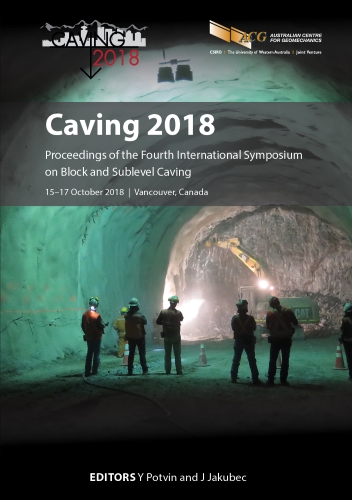Influence of rock mass veining and non-persistent joints on secondary fragmentation during block caving

|
Authors: Dorador, L; Eberhardt, E; Elmo, D |
DOI https://doi.org/10.36487/ACG_rep/1815_18_Dorador
Cite As:
Dorador, L, Eberhardt, E & Elmo, D 2018, 'Influence of rock mass veining and non-persistent joints on secondary fragmentation during block caving', in Y Potvin & J Jakubec (eds), Caving 2018: Proceedings of the Fourth International Symposium on Block and Sublevel Caving, Australian Centre for Geomechanics, Perth, pp. 271-282, https://doi.org/10.36487/ACG_rep/1815_18_Dorador
Abstract:
Reliable estimates of rock mass fragmentation are essential for pre-feasibility and feasibility-level assessments of drawpoint productivity in the planning of a block caving operation. The last stage of this fragmentation process is known as secondary fragmentation; secondary fragmentation is not well understood due to its complexity and the numerous influencing factors involved, but it plays a major role in the design and success of a caving operation. One of these factors is the strength of the rock blocks, for which the presence of planes of weakness in the form of veining and non-persistent joints is of special interest given the significant influence it potentially has on the overall fragmentation process. This paper summarises the results from a series of detailed experiments investigating the influence of soft veins and small discontinuities (i.e. defects) on the fragmentation characteristics of broken ore. Vein thickness (or joint opening) is shown to be a key parameter since thicker defects trigger a different fragmentation mechanism compared to thin defects. In terms of defect orientation, those aligned with the vertical loading direction were seen to contribute to fragmentation through simple splitting of the blocks. Conversely, block defects aligned perpendicular to the vertical loading direction promoted increased fragmentation through compressive failure. Of interest is that under a dense initial packing; the effect of defects is such that blocks with high matrix strengths that include defects showed comparable levels of fragmentation to blocks with matrix strengths several times weaker without defects. It is expected that these experimental results, together with advanced numerical models capable of explicitly modelling fragmentation (e.g. finite element method–discrete element method approach), would allow for the influence of block veining and non-persistent joints to be included in secondary fragmentation assessments for block caving operations.
Keywords: block caving, secondary fragmentation, laboratory testing, block veining
References:
ASTM International 2010, ASTM D698: Standard Test Methods for Laboratory Compaction Characteristics of Soil Using Standard Effort (12 400 ft-lbf/ft3 (600 kN-m/m3)), ASTM International, West Conshohocken.
ASTM International 2014, ASTM D7012: Standard Test Methods for Compressive Strength and Elastic Moduli of Intact Rock Core Specimens Under Varying States of Stress and Temperatures, ASTM International, West Conshohocken.
ASTM International 2016, ASTM D5731: Standard Test Method for Determination of the Point Load Strength Index of Rock and Application to Rock Strength Classifications, ASTM International, West Conshohocken.
Brzovic, A & Villaescusa, E 2007, ‘Rock mass characterization and assessment of block‐forming geological discontinuities during caving of primary copper ore at the El Teniente mine, Chile’, International Journal of Rock Mechanics and Mining Sciences, vol. 44, no. 4, pp. 565–583.
Dorador, L, Eberhardt, E & Elmo, D 2015, ‘Influence of block strength and veining on secondary fragmentation related to block caving’, Proceedings of the 13th International Congress of Rock Mechanics: Innovations in Applied and Theoretical Rock Mechanics, International Society for Rock Mechanics, Lisbon, paper 806.
Dorador, L 2016, Experimental Investigation of the Effect of Broken Ore Properties on Secondary Fragmentation During Block Caving, PhD thesis, The University of British Columbia, Vancouver.
Eadie, B 2003, A Framework for Modeling Fragmentation in Block Caving, PhD thesis, The University of Queensland, Brisbane.
Hardin, B 1985, ‘Crushing of soil particles’, Journal of Geotechnical Engineering, vol. 111, no. 10, pp. 1177–1192.
Laubscher, D 1994, ‘Cave mining – the state of the art’, Journal of the South African Institute of Mining Metallurgy, vol. 94, no. 10, pp. 279–293.
© Copyright 2026, Australian Centre for Geomechanics (ACG), The University of Western Australia. All rights reserved.
View copyright/legal information
Please direct any queries or error reports to repository-acg@uwa.edu.au
View copyright/legal information
Please direct any queries or error reports to repository-acg@uwa.edu.au
